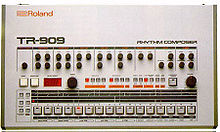TR-909
| TR-909 | |
|---|---|

TR-909 Front Panel
|
|
| Manufacturer | Roland |
| Dates | 1983-1985 |
| Price | US$1,195 UK£999 JP¥189,000 |
| Technical specifications | |
| Polyphony | 12 voices |
| Timbrality | none |
| Synthesis type |
Analog Subtractive and Digital Sample-based Subtractive |
| Aftertouch expression | No |
| Velocity expression | Yes |
| Storage memory | 96 Patterns, 8 Songs |
| Effects | Individual level, tuning, attack, decay, and tone controls for some sounds |
| Input/output | |
| Keyboard | 16 Pattern Keys |
| External control | MIDI In/Out & DIN Sync In |
The Roland TR-909 Rhythm Composer is a partially analog, partially sample-based, drum machine introduced by the Japanese Roland Corporation in 1983. The brainchild of Tadao Kikumoto, the engineer behind the Roland TB-303, it features a 16-step step sequencer and a drum kit that aimed for realism and cost-effectiveness. It is fully programmable, and like its predecessor, the TR-808, it can store entire songs with multiple sections, as opposed to simply storing patterns. It was the first MIDI-equipped drum machine. Around 10,000 units were produced.
The Roland 909 was launched three years after its Roland 808 forebear. The 909 was an improvement on the 808 because the 909 provide a part-analog synthesizer, part-sample-based sound generation hybrid. As with the 808, the 909 did not sound as realistic as the Linn and Oberheim that dominated the upper end of the drum machine market. As with the TB-303, the realism of the TR-909 was limited by technical constraints, and this showed when the machines were released at relatively low prices before its rise in popularity, coinciding with the beginnings of techno and acid house. More expensive, sample-based drum computers were better at faithfully reproducing real drum sounds, while the TR-909 sounded synthetic.
One of the first Roland instruments to be equipped with MIDI connectivity, a system that enables computerized instruments to communicate with each other, the TR909 combined analogue sound generation of its drum sounds with digital samples for its cymbal and hi-hat sounds. It contained a powerful music sequencer that enabled users to chain 96 patterns into songs of up to 896 measures. It also had numerous controls that let users tailor the sounds. The 909 also offered extra controls, such as "shuffle" and "flam". It sounded more realistic than its predecessors, and was moderately successful; however, the advent of purely sample-based drum modules would soon cause its demise. But, like the TR808 before it, the TR909 eventually came to be held in reverence by music producers, hip hop music DJs and beatmakers, and techno and other electronic dance music-style DJs. Much like the TR-808's importance to hip hop, the TR-909 holds a similar important for dance music, such as techno and house music. The TR909 soundset is part of Roland's AIRA TR-8 drum machine.
...
Wikipedia
